Celebrate the arrival of asparagus with a colourful menu for four
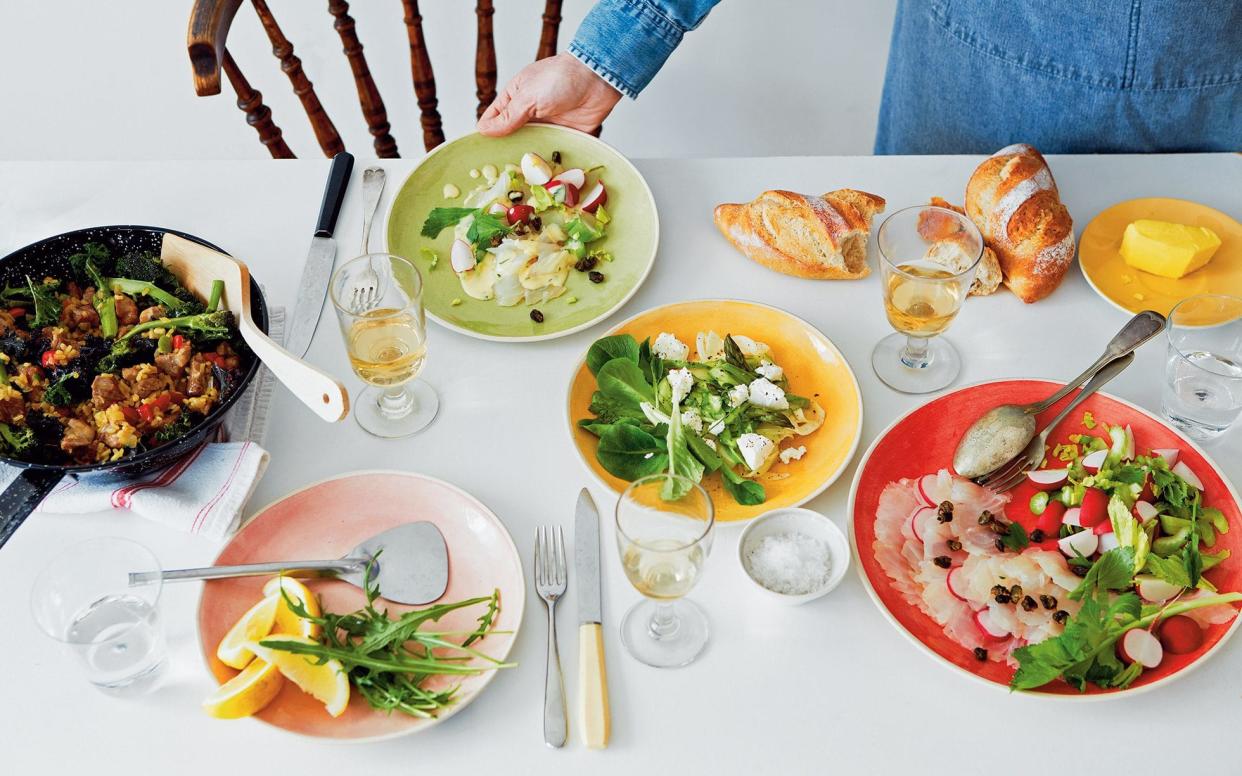
When I was a child, I could not see the point of asparagus. When, every April, my parents brought home the season’s first bunches of paper-wrapped spears from the greengrocer’s (of course), I wondered how adults could get so excited about the fat, leafless stalks with their pointed budding tops.
Greens were greens, to me. Something to be endured, hidden under a fork, even fed to a dog lurking under the table – not always successful, depending on the greed of the particular pet.
Appreciation began with the butter. A vegetable drenched in melting, salty butter had to have something going for it, I decided. Then there was the discovery of hollandaise sauce – this has promise, I agreed. There was a tendency for cooks to slightly overcook asparagus then, often through using that pointless wedding present, the asparagus steamer. Left a moment too long in enveloping, scorching vapour, the heads of asparagus spears flop lifelessly.
When my mother began to grow her own, however, a three-year build-up to a productive asparagus bed, I finally got it. Just picked, the stalks still have all the sugars that gradually turn to starch through storage. Picking them, I bit off a raw head of a small spear and sugary juice sprang out of it.
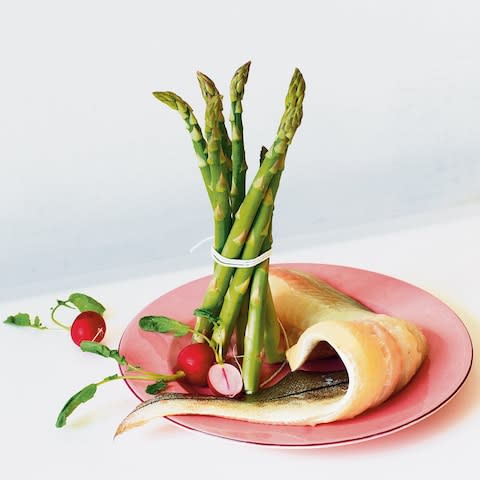
Cooked for just five minutes, still green and perky, finally I found the beauty of this uniquely flavoured vegetable and cannot wait for the season to begin. This year may be a classic, since the taste of asparagus is deeper when the ground has been as cold as it has.
Our supermarkets loyally sell a vast amount of UK asparagus, packed to stay on the shelves for as long as possible. While it is great that it is available and sold at a less luxurious price, the sweetness diminishes with storage, so I buy it from farmer’s markets or look for farm-gate buys – britishasparagus.com lists local farms.
Get cooking | Rose Prince’s latest recipes
When it is very fresh, I like to use spears from the new harvest raw, in a salad with fennel and ricotta, but as the spell continues it could turn up in anything from a soup to a baked, saffron-infused rice – a dish I make often.
The first spears pushing up from bare earth are a declaration of another pleasure: the beginning of the season for British berries, leafy greens, peas, beans and young root vegetables. The first strawberries, little pods full of broad beans – finally, we can enjoy a glut of home-grown. After this long winter, it is especially well deserved.
Baked pork and saffron rice

I probably make a version of this every other week, because it is an efficient way of using, not least using up, seasonal greens. It is based on a paella but is part-cooked in the oven, the vegetables steaming under a tent of greaseproof paper. Use the best saffron – if you make a tea from a few strands and store it in the fridge, you will get the most of this very expensive spice.
SERVES
4
INGREDIENTS
16 strands Spanish saffron
3 tbsp olive oil, plus a little extra to serve
1 pork neck fillet, about 400-500g, cut into 1cm dice
½ sweet red pepper, cut into very small dice
1 small onion, finely chopped
1 garlic clove, crushed to a paste with salt
½ tsp smoked paprika
5 tbsp paella rice
300ml chicken or other meat stock, or water, or as needed
150g greens (spring greens, chard or kale), any tough stalks removed, leaves cut into ribbons
200g asparagus or purple- sprouting broccoli, woody stems removed, then cut into 5cm sticks
100g broad beans or peas, podded
½ lemon, to squeeze
rocket, to serve
METHOD
Steep the saffron in 75ml boiling water, leaving it to infuse for at least 30 minutes. Preheat the oven to 200C/gas mark 6.
Heat the oil in a large ovenproof frying pan and fry the pork over a medium heat for five minutes. Add the sweet pepper, the onion, garlic and paprika and stir over the heat for a minute. Then pour in the saffron infusion, followed by the rice. Cook for a minute or two, stirring, then cover with the stock (or water) so it is 1cm deeper than the level of the rice. Bring to a simmer and cook slowly for about eight minutes.
Add the green vegetables to the pan, leaving them on top of the rice, and simmer for two minutes. Cover with a circle of greaseproof paper then put the pan in the oven for a further 10 minutes.
To serve, squeeze over some lemon juice and add a few drops of olive oil. Season with salt and pepper. Give it a quick and gentle stir before serving heaped on to plates, with the rocket.
Raw asparagus, fennel and ricotta
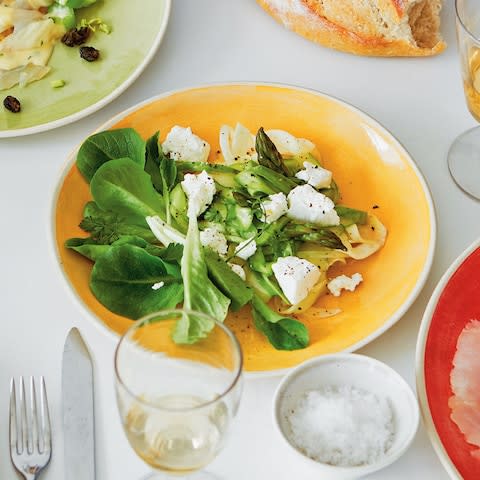
A salad that is all about the quality of the ingredients: if you can source asparagus that has just been picked – from your garden, a farmer’s market or a farm shop – it will be sweet enough to eat raw. With older, starchy asparagus, you’ll need to steam or boil the spears first. For the cheese, typical ricotta is fine, or seek out buffalo ricotta from an Italian specialist retailer, British-made Westcombe ricotta from Neals’s Yard Dairy – or, for a richer result, use burrata or buffalo mozzarella.
SERVES
4
INGREDIENTS
250g ricotta
400g asparagus spears
4-6 tbsp extra-virgin olive oil
1 fennel bulb, cut in half lengthways
juice of 1 lemon
a handful of baby-leaf salad, chervil or parsley
fresh ciabatta or sourdough bread, or toasted/grilled sourdough, to serve
At least an hour ahead, take the ricotta out of its packaging, put it into a sieve placed over a bowl and refrigerate. This is to dry it a little so it can be crumbled on to the salad. For burrata or mozzarella there is no need.
Snap off the lower part of the asparagus stem, which can be too woody to be eaten raw. Shave the outer membrane of the asparagus stalk, up to about 5cm from the tip, using a potato peeler. Cut each stem in half lengthways, bisecting it.
Place on a plate and drizzle over half the olive oil. Turn in the oil and season with salt.
Use a mandolin to cut wafer- thin slices of the fennel, then put it in a bowl with the lemon juice. Toss it, season with salt then add two tablespoons of the olive oil and turn the pieces to coat well.
Arrange both vegetables on a platter or board, then crumble the cheese over the surface. Scatter over some small salad leaves, or herbs – dress with a little extra oil, season and serve with the bread.
Smoked-haddock, radish and celery-leaf remoulade
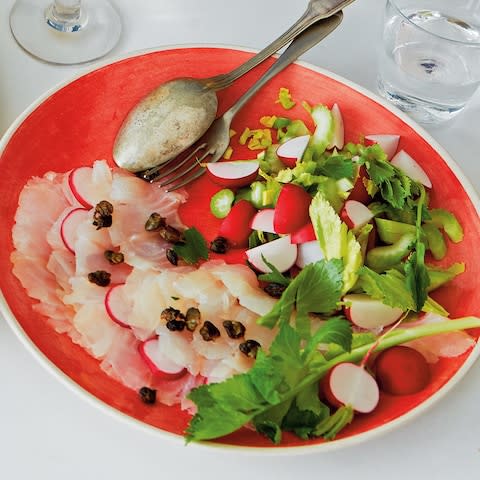
I grew up eating remoulade, the grated celeriac salad sold in French traiteurs, and love the flavour of the dressing especially – mustard, capers and tarragon have a special harmony. Celeriac is out of season, but the tender leaves in a celery heart lend the same flavours to this piquant salad. Artisan smokeries are a good source of plump smoked haddock fillets – I buy from the Chesil Smokery in West Dorset, which sells online (chesilsmokery.com). Eat this with bread, as a starter, or boiled new potatoes for a main dish.
SERVES
4 as a starter
INGREDIENTS
200g smoked haddock fillet
1 tbsp olive oil
2 tbsp fat capers, soaked then squeezed dry
leaves and soft stalks from the centre of a celery head
10 radishes, cut into slices or quarters, lengthways
tarragon leaves, to serve
For the dressing
2 egg yolks
1 tbsp Dijon mustard
125ml groundnut oil or grapeseed oil
a few drops of white-wine vinegar
a small handful of tarragon leaves, chopped
METHOD
Remove any pin bones from the flesh of the haddock with tweezers, cut away the skin, then wrap in cling film and place in the freezer for half an hour to 45 minutes – it is easier to slice when very cold.
To make the dressing, put the egg yolks in a mixing bowl and whisk in the mustard. Slowly add the oil, a few drops at a time to begin with, whisking all the time. Continue until all the oil has been beaten into the dressing – you can add larger quantities as you go on – until you have a thick emulsion. Add a few drops of vinegar to taste (you don’t want the dressing to be too sharp) then add a teaspoon of water to make the dressing looser. It should have the texture of double cream (add a little more water, if necessary). Season the dressing with salt and white pepper then stir in the chopped tarragon.
Heat the olive oil in a small pan then fry the capers. Let them take on a little colour then drain on kitchen paper.
Use a very sharp carving knife to cut the haddock into thin slices. To assemble, first scatter the celery leaves on to a flat platter or divide among individual plates. Chop the tender stalks and add to the plate(s), followed by the radishes, haddock slices and capers. Pour over the dressing and throw over some tarragon leaves.
Strawberry jelly with lime-basil syllabub
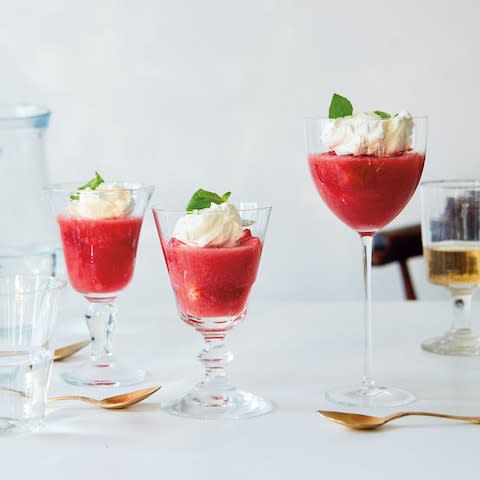
Uplifting, heralding summer: little tumblers of scarlet jelly topped with scented cream.
SERVES
4
INGREDIENTS
6 gelatin sheets (G Costa or Supercook brand)
500g strawberries, hulled
caster sugar, to taste
For the syllabub
200ml double cream
juice and grated zest of 1 lime
2 tsp caster sugar
10 basil leaves, torn into small pieces, plus a few small leaves to decorate
METHOD
Put the gelatin leaves into a bowl of cold water and leave to soak until soft.
Cut about one third of the strawberries into quarters and set aside in the fridge.
Put the remaining strawberries into a pan with 150ml water and bring to a simmer. Cook until soft then blitz to a smooth purée in a food processor. Taste and add a little sugar if needed.
Squeeze the gelatin leaves to rid them of excess water and put them in a saucepan with about four tablespoons of water. Melt over a very low heat – do not let the mixture boil at all. Add the puréed strawberry and stir well. Allow to cool to room temperature, stirring occasionally.
Divide the cut strawberries between four glass tumblers, then pour the gelatin mixture over the fruit to cover by about 1cm. Place in the fridge to set.
To make the syllabub, put the cream in a bowl and add the lime juice and zest. Whisk slowly until the cream thickens (not too much) then stir in the sugar and basil leaves. Just before serving, spoon a heaped tablespoonful of the syllabub over the strawberry jellies and top with a basil leaf or two. These puddings store well in the fridge for about an hour.

